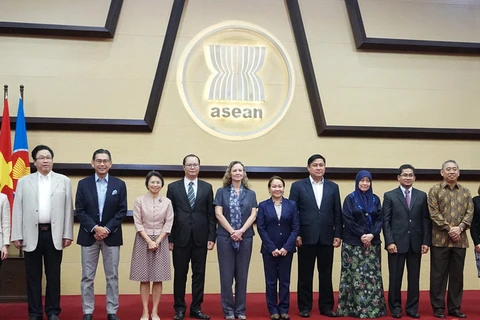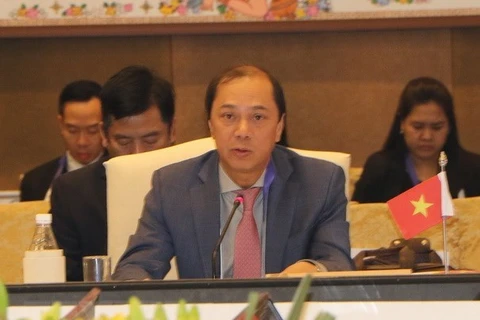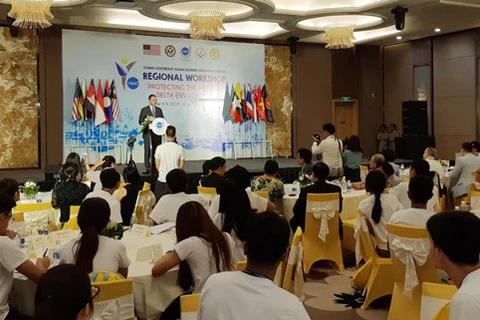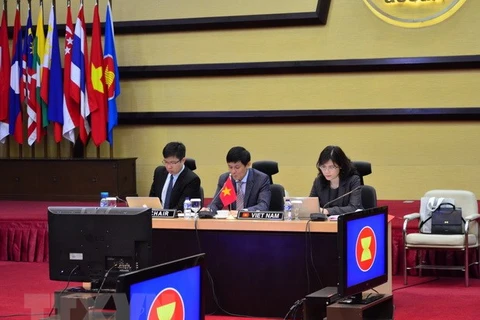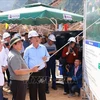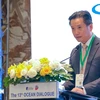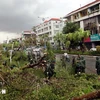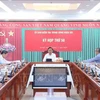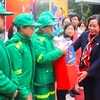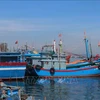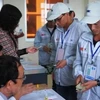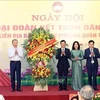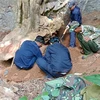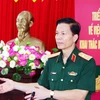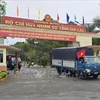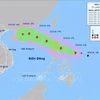Da Nang (VNA) – A mid-term review conference on Project 161 – which looks to implement and achieve the goals laid out by the ASEAN Socio-Cultural Community until 2025 – in the central region took place in Da Nang city on July 23.
Speaking at the event, Deputy Minister of Labour, Invalids and Social Affairs Doan Mau Diep said the ASEAN Community was officially established on December 31, 2015 on the pillars of political-security, economic, and socio-cultural communities, marking an important milestone to lift ASEAN collaboration to a greater height and requiring member states to build a community of over 630 million people in an environment of peace, friendship, and mutual support and development.
Towards achieving the ASEAN Vision 2025, the bloc has devised three master plans of the pillars, serving as a guide for their specialised agencies’ operations by 2025.
Diep said the conference aimed to update the progress of carrying out the master plan on ASEAN Socio-Cultural Community 2025 at the regional level and Project 161 in Vietnam; ASEAN’s communications activities and a communications plan towards Vietnam’s ASEAN Chairmanship by 2020. It also discussed a mechanism to enhance cooperation among ministries, agencies, and localities in the implementation of Project 161.
The outcomes of the review and recommendations to accelerate the progress of Project 161 will be submitted to the Prime Minister later this year.
Ha Thi Minh Duc, deputy head of the Ministry of Labour, Invalids, and Social Affairs’ Department of International Cooperation, said nine out of 11 Vietnamese ministries and agencies, as part of the ASEAN Socio-Cultural Community, have outlined plans to realise the project.
Up to 54 out of 63 cities and provinces nationwide have issued 2016-2020 action plans to conduct the project, and 39 out of 63 cities and provinces have submitted reports on the progress of the project thus far.
She added that the national master plan on ASEAN Socio-Cultural Community aims to bring benefits to people in tandem with improving institutional capacity, reforming administrative procedures, and raising public awareness of ASEAN and the benefits it brings about. This will work towards extending policies on social welfare, labour, employment, health care, and support for the elderly, disabled, and other vulnerable groups.
This year, the ASEAN Socio-Cultural Community gives priority to youth-based initiatives, including restoring the Singapore-ASEAN Youth Fund; introducing the ASEAN youth scholarship programme; strengthening commitment to coping with climate change; core values in understanding digitalisation; mitigating negative impacts of fake news; “Network of ASEAN smart cities” to improve living environment and livelihoods of people living in regional urban areas; and increasing opportunities for regional enterprises in a market of 630 million people.
Deputy Director of the Da Nang Department of Labour, Invalids, and Social Affairs Nguyen Van An said the city has held periodic job fairs, offered free vocational training and consultancy, as well as assisted firms and households in site clearance.
Last year, the municipal authorities visited and presented gifts to families of invalids and martyrs at a cost of over 100 billion VND (4.4 million USD), ensured regular allowances worth roughly 400 billion VND for nearly 22,000 policy beneficiaries, and repaired and upgraded martyrs’ tombs.
The municipal Ho Chi Minh Communist Youth Union launched voluntary movements, youth and and music exchanges with ASEAN member states to popularise the image of Vietnam and Da Nang in particular.-VNA
Speaking at the event, Deputy Minister of Labour, Invalids and Social Affairs Doan Mau Diep said the ASEAN Community was officially established on December 31, 2015 on the pillars of political-security, economic, and socio-cultural communities, marking an important milestone to lift ASEAN collaboration to a greater height and requiring member states to build a community of over 630 million people in an environment of peace, friendship, and mutual support and development.
Towards achieving the ASEAN Vision 2025, the bloc has devised three master plans of the pillars, serving as a guide for their specialised agencies’ operations by 2025.
Diep said the conference aimed to update the progress of carrying out the master plan on ASEAN Socio-Cultural Community 2025 at the regional level and Project 161 in Vietnam; ASEAN’s communications activities and a communications plan towards Vietnam’s ASEAN Chairmanship by 2020. It also discussed a mechanism to enhance cooperation among ministries, agencies, and localities in the implementation of Project 161.
The outcomes of the review and recommendations to accelerate the progress of Project 161 will be submitted to the Prime Minister later this year.
Ha Thi Minh Duc, deputy head of the Ministry of Labour, Invalids, and Social Affairs’ Department of International Cooperation, said nine out of 11 Vietnamese ministries and agencies, as part of the ASEAN Socio-Cultural Community, have outlined plans to realise the project.
Up to 54 out of 63 cities and provinces nationwide have issued 2016-2020 action plans to conduct the project, and 39 out of 63 cities and provinces have submitted reports on the progress of the project thus far.
She added that the national master plan on ASEAN Socio-Cultural Community aims to bring benefits to people in tandem with improving institutional capacity, reforming administrative procedures, and raising public awareness of ASEAN and the benefits it brings about. This will work towards extending policies on social welfare, labour, employment, health care, and support for the elderly, disabled, and other vulnerable groups.
This year, the ASEAN Socio-Cultural Community gives priority to youth-based initiatives, including restoring the Singapore-ASEAN Youth Fund; introducing the ASEAN youth scholarship programme; strengthening commitment to coping with climate change; core values in understanding digitalisation; mitigating negative impacts of fake news; “Network of ASEAN smart cities” to improve living environment and livelihoods of people living in regional urban areas; and increasing opportunities for regional enterprises in a market of 630 million people.
Deputy Director of the Da Nang Department of Labour, Invalids, and Social Affairs Nguyen Van An said the city has held periodic job fairs, offered free vocational training and consultancy, as well as assisted firms and households in site clearance.
Last year, the municipal authorities visited and presented gifts to families of invalids and martyrs at a cost of over 100 billion VND (4.4 million USD), ensured regular allowances worth roughly 400 billion VND for nearly 22,000 policy beneficiaries, and repaired and upgraded martyrs’ tombs.
The municipal Ho Chi Minh Communist Youth Union launched voluntary movements, youth and and music exchanges with ASEAN member states to popularise the image of Vietnam and Da Nang in particular.-VNA
VNA

